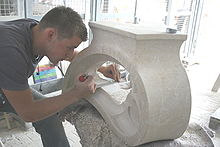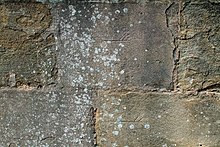| This article does not cite any references or sources. Please help improve this article by adding citations to reliable sources. Unsourced material may be challenged and removed. (April 2008) |

Stonemason working on a fountain with pneumatic tools
The craft of stonemasonry has existed since the dawn of civilization - creating buildings, structures, and sculpture using stone from the earth. These materials have been used to construct many of the long-lasting, ancient monuments, artifacts, cathedrals, and cities in a wide variety of cultures.
Definition[]

Typical Aberdeen city street showing the widespread use of local granite

19th Century Colonial Secretary's Office in Sydney, Australia constructed of typical Sydney sandstone
Stonemasonry is the craft of shaping rough pieces of rock into accurate geometrical shapes, mostly simple, but some of considerable complexity, and then arranging the resulting stones, often together with mortar, to form structures.
- Quarrymen split the rock, and extract the resulting blocks of stone from the ground.
- Sawyers cut these rough blocks into cubes, to required size with diamond-tipped saws.
- Banker masons are workshop based, and specialize in carving stones into intricate geometrical shapes required by a building's design. They can produce anything from stones with simple chamfers to tracery windows, detailed mouldings and the more classical architectural building masonry. When working a stone from a sawn block, the mason ensures that the stone is bedded in the right way, so the finished work sits in the building in the same orientation as it was formed on the ground. The basic tools, methods and skills of the banker mason have existed as a trade for thousands of years.
- Carvers cross the line from craft to art, and use their artistic ability to carve stone into foliage, figures, animals or abstract designs.
- Fixer masons specialize in the fixing of stones onto buildings, using lifting tackle, and traditional lime mortars and grouts. Sometimes modern cements, mastics and epoxy resins are used, usually on specialist applications such as stone cladding. Metal fixings, from simple dowels and cramps to specialised single application fixings, are also used. The precise tolerances necessary make this a highly skilled job.
- Memorial masons or monumental masons carve gravestones and inscriptions.
The modern stonemason undergoes comprehensive training, both in the classroom and in the working environment. Hands-on skill is complimented by intimate knowledge of each stone type, its application and best uses, and how to work and fix each stone in place. The mason may be skilled and competent to carry out one or all of the various branches of stonemasonry. In some areas the trend is towards specialization, in other areas towards adaptability.
Types of stone[]

A stonemason at Eglinton Tournament bridge with a selection of tools of the trade

A stonemason's stone workbench from the 1845 Eglinton Tournament bridge construction
Stonemasons use all types of natural stone: igneous, metamorphic and sedimentary; while some also use artificial stone as well.
Igneous stones[]
Granite is one of the hardest stones, and requires such different techniques to sedimentary stones that it is virtually a separate trade. With great persistence, simple mouldings can and have been carved into granite, for example in many Cornish churches and the city of Aberdeen. Generally, however, it is used for purposes that require its strength and durability, such as kerbstones, countertops, flooring, and breakwaters.
Igneous stone ranges from very soft rocks such as pumice and scoria to somewhat harder rocks such as tuff and hard rocks such as obsidian, granite and basalt.
Metamorphic[]
Marble has traditionally been used for carving statues, and for facing many Byzantine and Renaissance Italian buildings. The traditional home of the marble industry is the area around Carrara in Italy, from where a bright white marble is extracted in vast quantities.
Slate is a popular choice of stone for memorials and inscriptions, as its fine grain and hardness means it leaves details very sharp. Meanwhile, its tendency to split into thin plates has made it a popular roofing material.
Sedimentary[]
Many of the world's most famous buildings have been built of sedimentary stone, from Durham Cathedral to St Peter's in Rome. There are two main types of sedimentary stone used in masonry work, limestones and sandstones. Examples of limestones include Bath and Portland stone. Yorkstone and Sydney sandstone are well-known sandstones.
Types of stonemasonry[]
Types of stonemasonry are:
- When roughly dressed stones are laid in a mortar the result is a stone rubble masonry.
- Ashlar Masonry
- Well arranged and cut stones put in cement mortar.
Training[]
Traditionally medieval stonemasons served a seven-year apprenticeship. A similar system still operates today.
A modern apprenticeship lasts four years. This combines on-site learning through personal experience, the experience of the tradesmen and college work where apprentices are given an overall experience of the building, hewing and theory work involved in masonry. In some areas colleges offer courses which teach not only the manual skills but also related fields such as drafting and blueprint reading or construction conservationism. Electronic Stonemasonry training resources enhance traditional delivery techniques.[1] Hands-on workshops are a good way to learn about stonemasonry also.[2] Those wishing to become stonemasons should have little problem working at heights, possess reasonable hand-eye co-ordination, be moderately physically fit, and have basic mathematical ability. Most of these things can be developed while learning.
Tools[]
The foreground tool with serrated blades is a cockscomb, cock's comb or stonemason's drag, used on soft limestone
Stonemasons use a wide variety of tools to handle and shape stone blocks (ashlar) and slabs into finished articles. The basic tools for shaping the stone are a mallet, chisels, and a metal straight edge. With these one can make a flat surface - the basis of all stone masonry.
Chisels come in a variety of sizes and shapes, dependent upon the function for which they are being used. There are different chisels for different materials and sizes of material being worked, for removing large amounts of material and for putting a fine finish on the stone.
Mixing mortar is normally done today with mortar mixers which usually use a rotating drum or rotating paddles to mix the mortar.
The masonry trowel is used for the application of the mortar between and around the stones as they are set into place. Filling in the gaps (joints) with mortar is referred to as pointing. Pointing in smaller joints can be accomplished using tuck pointers, pointing trowels, and margin trowels, among other tools.
At least one tool bears the name of the tradesmen that use it, and that is the Stonemason's hammer. This hammer can be used in place of a chisel in certain circumstances. The hammer can also be used to make shims and chinks while holding a small stone in one hand and striking it with the hammer.
Stonemasons use a Lewis together with a crane or winch to hoist building stones into place.
Today power tools such as compressed-air chisels, abrasive spinners and angle grinders are much used: these save time and money, but are hazardous and require just as much skill as the hand tools that they augment. But many of the basic tools of stonemasonry have remained virtually the same throughout vast amounts of time, even thousands of years.
History[]
Stonemasonry is one of the earliest trades in civilisation's history. During the time of the Neolithic Revolution and domestication of animals, people learned how to use fire to create quicklime, plasters, and mortars. They used these to fashion homes for themselves with mud, straw, or stone, and masonry was born.
The Ancients heavily relied on the stonemason to build the most impressive and long lasting monuments to their civilisations. The Egyptians built their pyramids, the civilizations of Central American had their step pyramids, the Persians their palaces, the Greeks their temples, and the Romans their public works and wonders (See Roman Architecture). Among the famous ancient stonemasons is Sophroniscus, the father of Socrates, who was a stone-cutter.
Castle building was an entire industry for the medieval stonemasons. When the Western Roman Empire fell, building in dressed stone decreased in much of Western Europe, and there was a resulting increase in timber-based construction. Stone work experienced a resurgence in the 9th and 10th centuries in Europe, and by the 12th century religious fervour resulted in the construction of thousands of impressive churches and cathedrals in stone across Western Europe.
Medieval stonemasons' skills were in high demand, and members of the guild, gave rise to three classes of stonemasons: apprentices, journeymen, and master masons. Apprentices were indentured to their masters as the price for their training, journeymen had a higher level of skill and could go on journeys to assist their masters, and master masons were considered freemen who could travel as they wished to work on the projects of the patrons. During the Renaissance, the stonemason's guild admitted members who were not stonemasons, and eventually evolved into the Society of Freemasonry; fraternal groups which observe the traditional culture of stonemasons, but are not typically involved in modern construction projects.
A medieval stonemason would often carve a personal symbol onto their block to differentiate their work from that of other stonemasons. This also provided a simple ‘quality assurance’ system.
The Renaissance saw stonemasonry return to the prominence and sophistication of the Classical age. The rise of the Humanist philosophy gave people the ambition to create marvelous works of art. The centre stage for the Renaissance would prove to be Italy, where city-states such as Florence erected great structures, including the Cathedral of Santa Maria del Fiore, the Fountain of Neptune, and the Laurentian Library which was planned and built by Michelangelo Buonarroti, a famous stonemason of the Renaissance.
When Europeans settled the Americas, they brought the stonemasonry techniques of their respective homelands with them. Settlers used what materials were available, and in some areas stone was the material of choice. In the first waves, building mimicked that of Europe, to eventually be replaced by unique architecture later on.
In the 20th century, stonemasonry saw its most radical changes in the way the work is accomplished. Prior to the first half of the century, most heavy work was executed by draft animals or human muscle power. With the arrival of the internal combustion engine, many of these hard aspects of the trade have been made simpler and easier. Cranes and forklifts have made moving and laying heavy stones relatively easy for the stonemasons. Motor powered mortar mixers have saved much in time and energy as well. Compressed-air powered tools have made working of stone less time-intensive. Petrol and electric powered abrasive saws can cut through stone much faster and with more precision than chiseling alone. Carbide-tipped chisels can stand up to much more abuse than the steel and iron chisels made by blacksmiths of old.
Gallery[]
See also[]
- NIST stone test wall
- Stone wall
- Dry-stone wall
- Masonry
- Architecture
- Stonemasonry tools
External links[]
| Wikimedia Commons has media related to Stonemasonry that may be added |
| Wikimedia Commons has media related to Stonemasons in art that may be added |
| Wikimedia Commons has media related to Stone industries that may be added |
- Stonemasonry project on medieval bridge
- Stonemason occupation information
- The Stone Foundation
- About Stone
References[]
This page is being imported from Wikipedia, to create a Wikidwelling stub or article. These steps need to be completed:
The original article was at Stonemasonry. The list of authors can be seen in the history for that page. The text of Wikipedia is available under the CC-BY-SA 3.0 license. |









